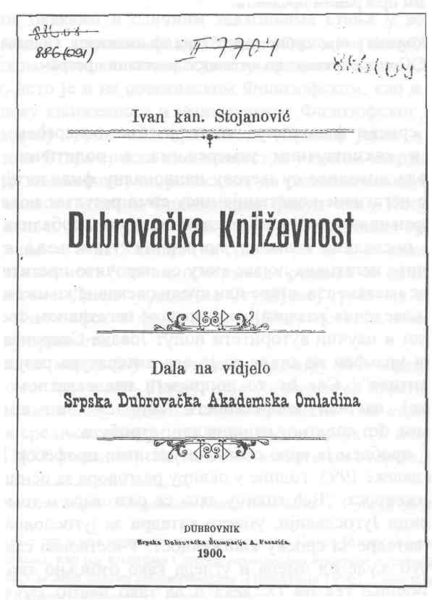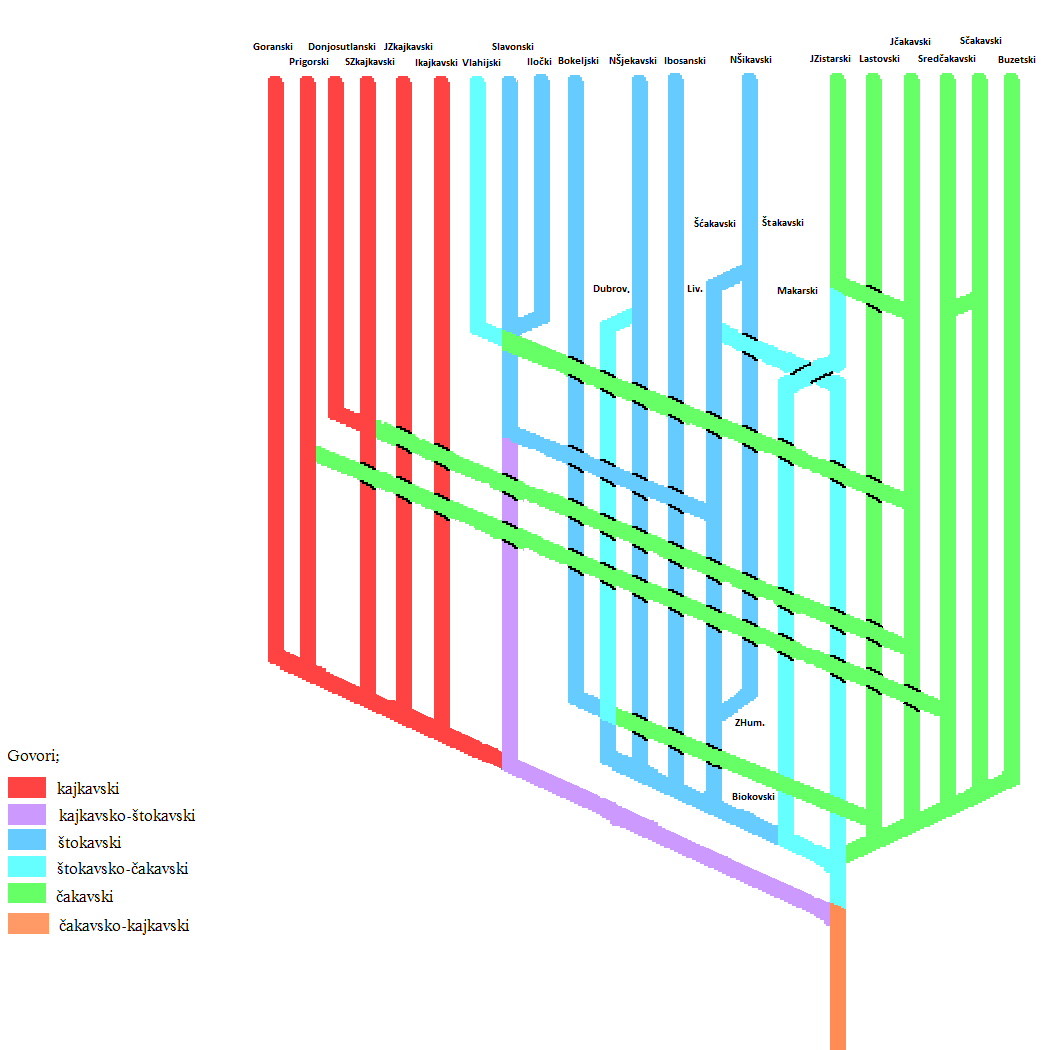|
Milan Rešetar
Milan Rešetar (February 1, 1860 – January 14, 1942) was a linguist, historian and literary critic from Dubrovnik. Biography Rešetar was born in Dubrovnik. After the gymnasium in Dubrovnik, he studied classical philology and Slavic languages in Vienna and Graz. He worked as a high-school professor in Koper, Zadar and Split, and later a professor of Slavic studies on the universities of Vienna and Zagreb). He also edited the Croatian edition of "''List drevnih zakona''" magazine. Rešetar was a student of Vatroslav Jagić. He was a notable member of the Serb-Catholic movement in Dubrovnik. After retirement, he moved to Florence where he died 1942. The main areas of his works included dialectology and accentology of South Slavic languages, as well as philologically impeccable editions of 15th to 18th century writers for the Yugoslav Academy of Sciences and Arts. He was one of founders of South Slavic dialectology, investigating features of Štokavian dialects (''Der Štoka ... [...More Info...] [...Related Items...] OR: [Wikipedia] [Google] [Baidu] |
Dubrovnik
Dubrovnik, historically known as Ragusa, is a city in southern Dalmatia, Croatia, by the Adriatic Sea. It is one of the most prominent tourist destinations in the Mediterranean Sea, Mediterranean, a Port, seaport and the centre of the Dubrovnik-Neretva County. In 2021, its total population was 41,562. Recognizing its outstanding medieval architecture and fortifications, UNESCO inscribed the Old City of Dubrovnik as a World Heritage Site in 1979. The history of the city probably dates back to the 7th century, when the town known as was founded by refugees from Epidaurum (). It was under protectorate of the Byzantine Empire and later under the sovereignty of the Republic of Venice. Between the 14th and 19th centuries, Dubrovnik ruled itself as a Free state (polity), free state. The prosperity of the city was historically based on trade, maritime trade; as the capital of the maritime Republic of Ragusa, it achieved a high level of development, particularly during the 15th and 16t ... [...More Info...] [...Related Items...] OR: [Wikipedia] [Google] [Baidu] |
Serb-Catholic Movement In Dubrovnik
The Serb-Catholic movement in Dubrovnik ( sh-Cyrl-Latn, separator=" / ", Дубровачки србокатолички покрет, Dubrovački srbokatolički pokret) was a cultural and political movement of people from Dubrovnik who, while Catholic, declared themselves Serbs, while Dubrovnik was part of the Habsburg-ruled Kingdom of Dalmatia in the 19th and early 20th centuries. Initially spearheaded by intellectuals who espoused strong pro-Serbian sentiments, there were two prominent incarnations of the movement: an early pan-Slavic phase under Matija Ban and Medo Pucić that corresponded to the Illyrian movement, and a later, more Serbian nationalist group that was active between the 1880s and 1908, including a large number of Dubrovnik intellectuals at the time. The movement, whose adherents are known as Serb-Catholics () or Catholic Serbs (), largely disappeared with the creation of Yugoslavia. Background Ragusa was founded in the 7th century by refugees from Epidaurum ... [...More Info...] [...Related Items...] OR: [Wikipedia] [Google] [Baidu] |
Petar II Petrović-Njegoš
Petar II Petrović-Njegoš ( sr-cyrl, Петар II Петровић-Његош, ; – ), commonly referred to simply as Njegoš (), was a List of rulers of Montenegro, Prince-Bishop (''vladika'') of Montenegro, poet and philosopher whose works are widely considered some of the most important in Montenegrin and Serbian literature. Njegoš was born in the village of Njeguši, near Montenegro's then-capital Cetinje. He was educated at several Serbian monasteries and became the country's spiritual and political leader following the death of his uncle Petar I Petrović-Njegoš, Petar I. After eliminating all initial domestic opposition to his rule, he concentrated on uniting Montenegro's tribes and establishing a centralized state. He introduced regular taxation, formed a personal guard and implemented a series of new laws to replace those composed by his predecessor many years earlier. His taxation policies proved extremely unpopular with the tribes of Montenegro and were the ... [...More Info...] [...Related Items...] OR: [Wikipedia] [Google] [Baidu] |
Kotor
Kotor (Cyrillic script, Cyrillic: Котор, ), historically known as Cattaro (from Italian language, Italian: ), is a town in Coastal Montenegro, Coastal region of Montenegro. It is located in a secluded part of the Bay of Kotor. The city has a population of 13,347 and is the administrative center of Kotor Municipality. The old Mediterranean port of Kotor is surrounded by fortifications of Kotor, fortifications built during the Republic of Venice, Venetian period. It is located on the Bay of Kotor (''Boka Kotorska''), one of the most indented parts of the Adriatic Sea. Some have called it the southernmost fjord in Europe, but it is a ria, a submerged river canyon. Together with the nearly overhanging limestone cliffs of Orjen and Lovćen, Kotor and its surrounding area form an impressive landscape. Since the early 2000s Kotor has seen an increase in tourists, many of them coming by cruise ship. Visitors are attracted to the natural environment of the Bay of Kotor and the old ... [...More Info...] [...Related Items...] OR: [Wikipedia] [Google] [Baidu] |
Numismatics
Numismatics is the study or collection of currency, including coins, tokens, paper money, medals, and related objects. Specialists, known as numismatists, are often characterized as students or collectors of coins, but the discipline also includes the broader study of money and other means of payment used to resolve debts and exchange good (economics), goods. The earliest forms of money used by people are categorised by collectors as "odd and curious", but the use of other goods in barter exchange is excluded, even where used as a circulating currency (e.g., cigarettes or instant noodles in prison). As an example, the Kyrgyz people used horses as the principal currency unit, and gave small change in sheepskin, lambskins; the lambskins may be suitable for numismatic study, but the horses are not. Many objects have been used for centuries, such as Cowry, cowry shells, precious metals, Cocoa beans#History, cocoa beans, Rai stones, large stones, and Gemstone, gems. Etymology Firs ... [...More Info...] [...Related Items...] OR: [Wikipedia] [Google] [Baidu] |
The Mountain Wreath
''The Mountain Wreath'' () is a poem and a play written by Prince-Bishop and poet Petar II Petrović-Njegoš. Njegoš wrote ''The Mountain Wreath'' during 1846 in Cetinje and published it the following year after the printing in an Armenian monastery in Vienna. It is a modern epic written in verse as a play, thus combining three of the major modes of literary expression. It is considered a masterpiece of Serbian and Montenegrin literature. Themes Set in 18th-century Montenegro, the poem deals with attempts of Njegoš's ancestor Metropolitan Danilo I Petrović-Njegoš to regulate relations among the region's warring tribes. Written as a series of fictitious scenes in the form of dialogues and monologues, the poem opens with Metropolitan Danilo's vision of the spread of Turkish power in Europe. Torn by inner conflict he sees that the struggle is inevitable, but dreads the issues. [...More Info...] [...Related Items...] OR: [Wikipedia] [Google] [Baidu] |
Molise Croatian Dialect
''Slavomolisano'', also known as Molise Slavic or Molise Croatian (; ), is a variety of Shtokavian Croatian spoken by Italian Croats in three villages – Montemitro (), Acquaviva Collecroce () and San Felice del Molise () – in the province of Campobasso, in the Molise Region of southern Italy. There are fewer than 1,000 active speakers, and fewer than 2,000 passive speakers. It has been preserved since a group of Croats emigrated from Dalmatia due to the advancing Ottoman Turks. The residents of these villages speak a Shtokavian Younger Ikavian dialect with a strong Southern Chakavian adstratum. The Molise Croats consider themselves to be Slavic Italians, with South Slavic heritage and who speak a Slavic language, rather than simply ethnic Slavs or Croats. Some speakers call themselves or and call their language simply ("our language"). History According to evidence Croats arrived in Molise in the early 16th century. The documents from the episcopal archive of ... [...More Info...] [...Related Items...] OR: [Wikipedia] [Google] [Baidu] |
Čakavian
Chakavian or Čakavian (, , , proper name: or own name: ''čokovski, čakavski, čekavski'') is a South Slavic languages, South Slavic supradialect or language spoken by Croats along the Adriatic coast, in the historical regions of Dalmatia, Istria, Croatian Littoral and parts of coastal and southern Central Croatia (now collectively referred to as Adriatic Croatia or Littoral Croatia), as well as by the Burgenland Croats as Burgenland Croatian in southeastern Austria, northwestern Hungary and southwestern Slovakia as well as few municipalities in southern Slovenia on the border with Croatia. Chakavian represents the basis for early literary standards in Croatia, and until the modern age was simply known and understood, along with the Kajkavian and Shtokavian idioms in Croatia, as the Croatian language (''hrvatski jezik''). Legal and liturgical to literary texts until the 16th century, including literary work by "the father of Croatian literature" Marko Marulić and the fir ... [...More Info...] [...Related Items...] OR: [Wikipedia] [Google] [Baidu] |
Štokavian
Shtokavian or Štokavian (; sh-Latn, štokavski / sh-Cyrl, italics=no, штокавски, ) is the prestige supradialect of the pluricentric Serbo-Croatian language and the basis of its Serbian, Croatian, Bosnian and Montenegrin standards. It is a part of the South Slavic dialect continuum. Its name comes from the form for the interrogative pronoun for "what" . This is in contrast to Kajkavian and Chakavian ( and also meaning "what"). Shtokavian is spoken in Serbia, Montenegro, Bosnia and Herzegovina, much of Croatia, and the southern part of Austria's Burgenland. The primary subdivisions of Shtokavian are based on three principles: one is different accents whether the subdialect is Old-Shtokavian or Neo-Shtokavian, second is the way the old Slavic phoneme ''yat'' has changed (Ikavian, Ijekavian or Ekavian), and third is presence of Young Proto-Slavic isogloss (Schakavian or Shtakavian). Modern dialectology generally recognises seven Shtokavian subdialects. Early h ... [...More Info...] [...Related Items...] OR: [Wikipedia] [Google] [Baidu] |
Yugoslav Academy Of Sciences And Arts
The Croatian Academy of Sciences and Arts (; , HAZU) is the national academy of Croatia. HAZU was founded under the patronage of the Croatian bishop Josip Juraj Strossmayer under the name Yugoslav Academy of Sciences and Arts (, JAZU) since its founder wanted to make it the central scientific and artistic institution of all South Slavs. Today, its main goals are encouraging and organizing scientific work, applying the achieved results, developing of artistic and cultural activities, carrying about the Croatian cultural heritage and its affirmation in the world, publishing the results of scientific research and artistic creativity and giving suggestions and opinions for the advancement of science and art in areas of particular importance to Croatia. The academy is divided into nine classes; social sciences, mathematical, physical and chemical sciences, natural sciences, medical sciences, philological sciences, Literature, Fine Arts, Musical Arts and Musicology, technical sciences ... [...More Info...] [...Related Items...] OR: [Wikipedia] [Google] [Baidu] |
South Slavic Languages
The South Slavic languages are one of three branches of the Slavic languages. There are approximately 30 million speakers, mainly in the Balkans. These are separated geographically from speakers of the other two Slavic branches (West Slavic languages, West and East Slavic languages, East) by a belt of German language, German, Hungarian language, Hungarian and Romanian language, Romanian speakers. History The first South Slavic language to be written (also the first attested Slavic language) was the variety of the Eastern South Slavic spoken in Thessaloniki, now called Old Church Slavonic, in the ninth century. It is retained as a liturgical language in Slavic Eastern Orthodox Church, Orthodox churches in the form of various local Church Slavonic language, Church Slavonic traditions. Classification The South Slavic languages constitute a Dialect continuum#South Slavic continuum, dialect continuum. Serbian, Croatian, Bosnian, and Montenegrin constitute a single dialect wit ... [...More Info...] [...Related Items...] OR: [Wikipedia] [Google] [Baidu] |






